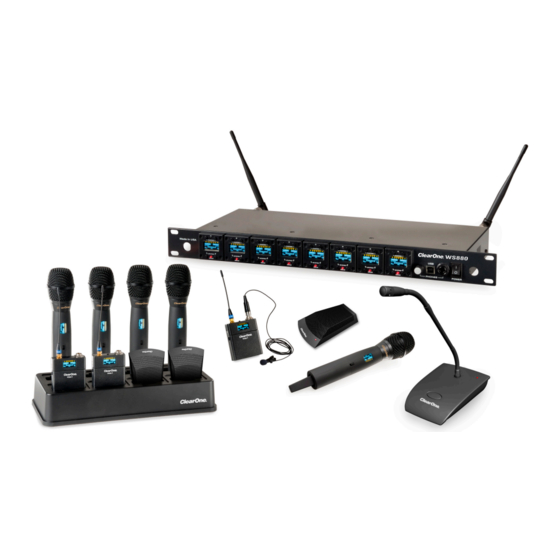- ページ 3
マイクシステム ClearOne WS800のPDF アプリケーション・マニュアルをオンラインで閲覧またはダウンロードできます。ClearOne WS800 12 ページ。 Wireless microphone system antenna application guide
ClearOne WS800 にも: クイック・スタート・マニュアル (10 ページ), クイック・スタート・マニュアル (15 ページ), マニュアル (5 ページ), クイック・スタート・マニュアル (13 ページ), アプリケーション・マニュアル (11 ページ)

The following case studies show how these rules may be applied in several common configurations:
Case I:
Flexible Configurations Conference Room
A.
1st Choice
Factor
Antennas on Ceiling
Equal
All of the transmitters are about the same distance to the closest antenna. If there is IMD interference it will be small com-
Distance
pared to the transmitter signal. It meets the design rule.
The antennas are separated so at least one antenna is always out of the null. Having two antennas reduces the chance
of an antenna failure causing a complete loss of signal (redundancy) and having distance between the antennas (space
Diversity
diversity) means that the normal variations in signal strength caused by the transmitter signals interacting with the envi-
ronment will be covered by the overlapping receiver antenna patterns. This meets the design rule.
Line of Sight
All transmitters are in the line of sight of both antennas. This meets the design rule.
Cable Loss
This configuration requires a shorter antenna run to the rack. It meets the design rule.
Range Loss
All transmitters are close to at least one antenna and have about the same gain. It meets the design rule.
Transmitter
The setup is ideal, so set the power to 1mW for extended battery life and minimal interference with systems in near-by rooms.
Power
Rating
Expect excellent performance in all room configurations.
B.
Not Recommended
Factor
Antennas On Back (or Front) Wall
The RF Signal of transmitters close to the receiver antennas can lower the sensitivity of the receiver so that transmitters
Equal
that are farther away do not have an adequate signal level at the receiver. Also using transmitters too close to the receiver
Distance
antennas or at too high of transmit power can cause Intermodulation Distortion which can either shadow desired transmit-
ter signals, or cause distortion in the receiver. Expect dropouts and hits with large numbers of transmitters.
The antennas are separated so at least one antenna is always out of the transmitter antenna's null. Having two antennas
reduces the chance of an antenna failure causing a complete loss of signal (redundancy) and having distance between
Diversity
the antennas (space diversity) means that the normal variations in signal strength caused by the transmitter signals inter-
acting with the environment will be covered by the overlapping receiver antenna patterns. This meets the design rule.
All transmitters are in the line of sight of both antennas, if they are high enough on the wall to not be blocked by people or
Line of Sight
obstacles on the stage. This meets the design rule
Cable Loss
Long cable runs require more expensive low-loss cable but it meets the design rule.
Range Loss
Transmitters away from the antennas have approximate 3 dB less gain than the close transmitters, but it meets the design rule.
Transmitter
Use 10 mW output power to assure pick-up of the far transmitters.
Power
Rating
This design is prone to dropouts and hits with large numbers or transmitters.
3
